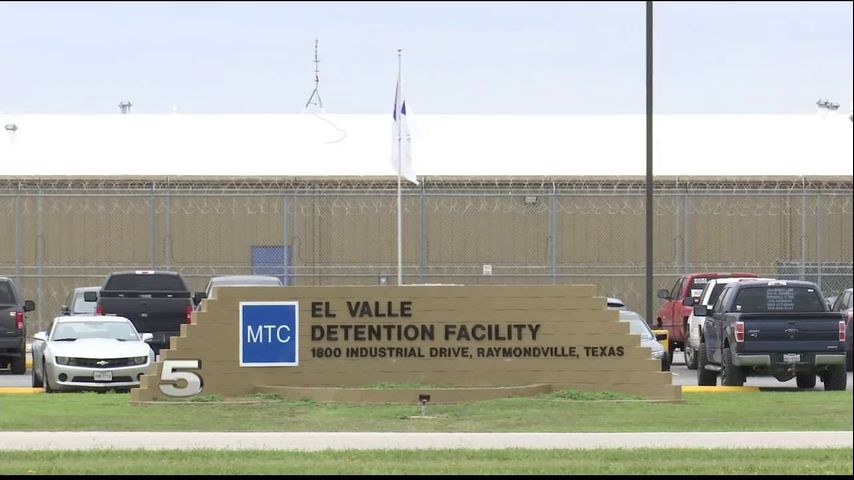Brief hunger strike at El Valle Detention Center protests long detention, conditions
WILLACY COUNTY — Missing soap, a lack of cleaning supplies and sick detainees pushed a group to protest July 20 in a hunger strike at El Valle Detention Facility.
The hunger strike was short-lived, but the women — from Mexico, Honduras and as far away as Ecuador — said they believed it necessary.
"We were cleaning our tables, where we eat, with pads, with pads, because they didn't have towels to clean up and sanitize our area," Maria Landa, a detainee at the detention center, said about staff not providing enough cleaning supplies. This claim was shared by other women at the center who spoke to Channel 5 News.
Landa and the other women are accused of violating immigration law. About 40 detainees were estimated to have protested on July 20. By July 21, the group shrank to more than a dozen.
ICE doesn't classify a protest as a hunger strike unless it lasts at least three days. Then, certain protocols are invoked.
The women who spoke with Channel 5 News said they've been kept in this center for months; one of them was there nine months, predating the pandemic.
Concerns from the outside world prompted extra attention to cleanliness, but Landa said they weren't always able to stay clean.
"Some of the restrooms, we were like three, four days without soap, because they didn't have any," Landa said. "How are we supposed to protect ourselves?"
The women started a hunger strike, Priscilla Rodriguez Zamora said. She's from Mexico and described neglect during the first time she and the others were placed under quarantine. Rodriguez Zamora said she believes they were exposed to the virus by a contracted employee who was assigned to watch their area.
Channel 5 News couldn't independently verify her story.
Management Training and Corp. of Centerville, Utah, the company contracted by ICE to run the detention center, sent a statement confirming that 10 employees had active COVID-19 cases. Ten others previously tested positive but had since recovered and were back at work.
Detainees suspected the threat moved closer with the arrival of a new detainee.
"They brought three new people, and one of them was infected," Jira Caracceoli, a detainee from Honduras, said.
Other detainees had similar stories. A new arrival, a woman, was held in quarantine for 14 days separately from those who were there already. After the period was over, the woman was placed in the dormitory with some of the women who participated in the hunger strike.
Detainees claim ICE took the woman in question to get tested as part of her deportation procedure. She tested positive.
Back at the dormitory, another woman started having symptoms.
An older woman had been sleeping next both of them.
"I was in the middle of both women that they took away. I'm 60 years old. It makes me fearful. I'm afraid of that," Juana Alban, the Ecuadorean detainee, said of the suspected cases of COVID-19.
As of July 17, the website for ICE listed eight positive cases among detainees housed at El Valle Detention Facility.
The women spoke on the record using their names because they wanted to reach out to ICE officers. The hunger strike started on July 20. By July 21, the remaining group still protesting was separated and taken to another dormitory. Later, Landa's husband said the women were able to speak to an ICE officer.
One of the concerns for 53-year-old woman, Lilia Bone, from Ecuador is her deportation orders.
They were issued on April 24, but as of late July she had not heard a response yet. According to ICE, some countries are not allowing their citizens to be repatriated because of the pandemic. The agency will be working with the U.S. State Department to make arrangements.
Others have had court dates pushed as far back as November. Detainees said the multiple quarantines created the legal setbacks.
Some of the concerns shared by the detainees line up with current practices enforced by ICE.
According to ICE, it uses an infection prevention strategy called "cohorting." That means ICE houses detainees together who are believed have been exposed to a person with an infectious agent but are asymptomatic.
Their policy should also allow for high-risk cases to be sent to the hospital. If the detainees don't have fever or symptoms but meet CDC criteria for being at risk, they are housed separately in a single cell or as a group, depending on available space.
Landa's husband said his wife's court date was moved from November to August.
Others will still be waiting for a decision.
"Whichever way, they can send us back to Ecuador or send us over there, as long as they take us out of here, that someone helps us," Bone, the Ecuadorean detainee, said.
Correction: This story incorrectly identified the detention facility where the hunger strike occurred. It is the El Valle Detention Facility in Willacy County.




